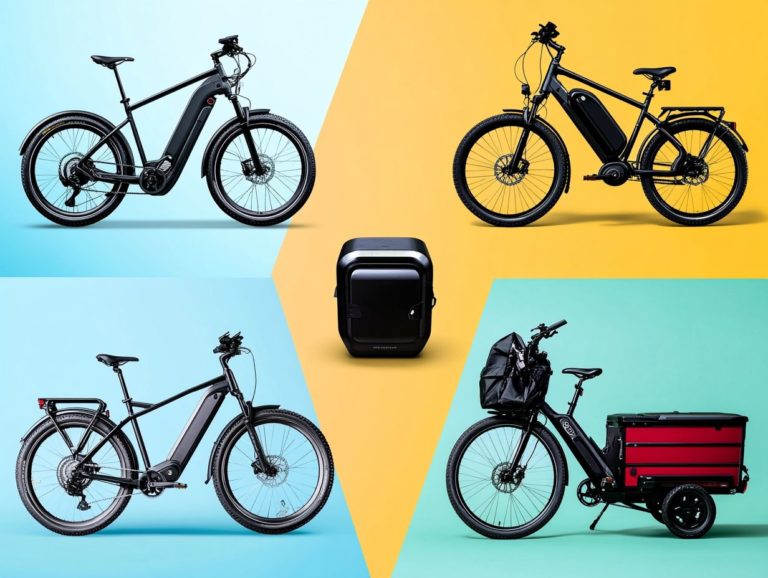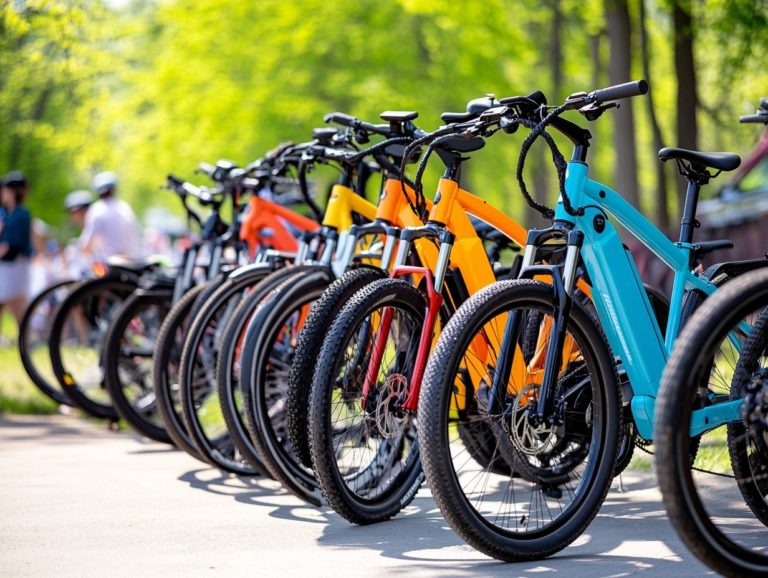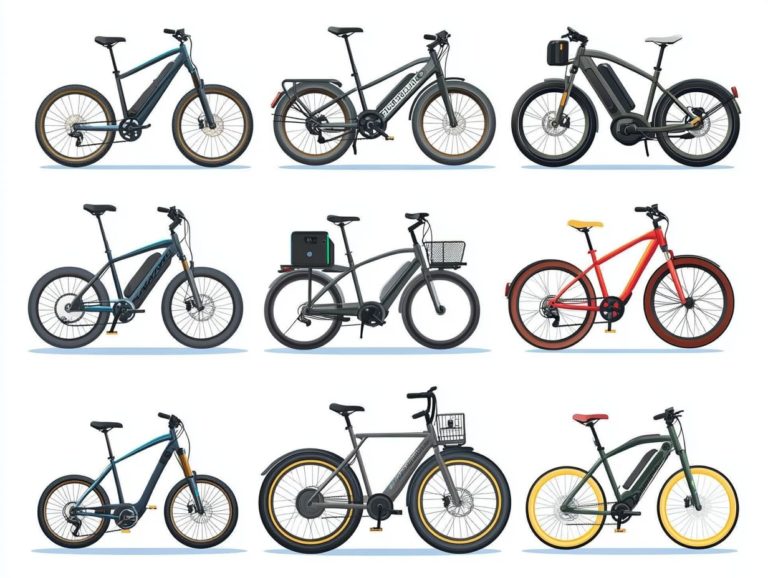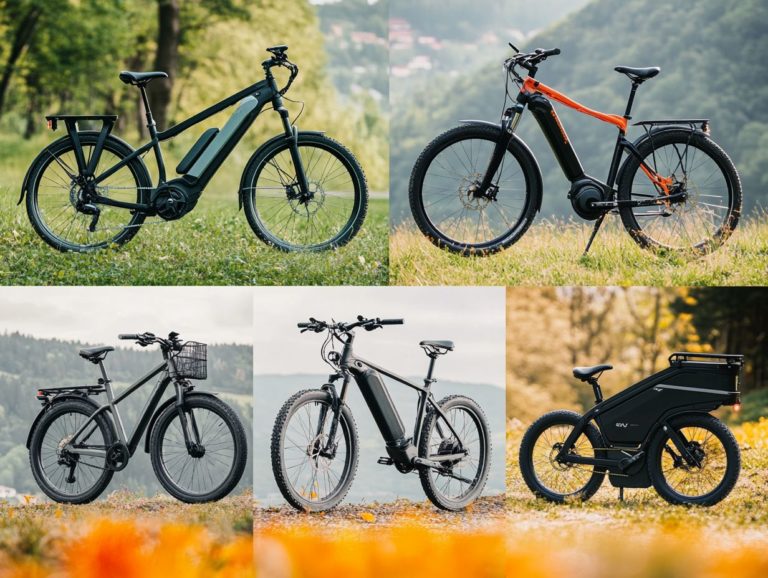5 Tips for Selecting the Right Electric Bike Type
Choosing the right electric bike can feel like navigating a labyrinth with countless paths to take. Whether you re an enthusiastic cyclist or a leisurely rider, understanding your unique riding style and needs is crucial.
This guide will provide you with five essential tips to help you select the perfect electric bike. We will focus on motor types, terrain considerations, budget, and the importance of test rides. You will also discover the different types of electric bikes available, along with their pros and cons, maintenance tips, and vital safety considerations.
Prepare to find the bike that perfectly aligns with your lifestyle!
Contents
- Key Takeaways:
- 1. Consider Your Riding Style and Needs
- 2. Choose the Right Motor and Battery for Your E-Bike
- 3. Think About the Terrain You Will Be Riding On
- 4. Test Ride Different Electric Bikes
- 5. Set a Budget and Do Your Research
- What Are the Different Types of Electric Bikes?
- Frequently Asked Questions
- What are the different types of electric bikes?
- What should I think about when choosing an electric bike?
- What is the difference between a pedal-assist and throttle electric bike?
- Which electric bike type is best for commuting?
- Do I need to test ride an electric bike before purchasing?
- Are there any legal restrictions for using electric bikes?
Key Takeaways:

- Consider your riding style and needs when selecting an electric bike to ensure the best fit for your lifestyle.
- Assess the type of motor and battery when choosing an electric bike, as this impacts performance and range.
- Keep in mind the terrain you will be riding on; different electric bikes suit different terrains.
1. Consider Your Riding Style and Needs
When selecting the perfect electric bike, or e-bike, it s essential to think about your riding style and needs. Whether you re commuting daily through the city on an urban e-bike, enjoying leisurely rides on a comfortable commuter bike, or hauling cargo with a specialized cargo e-bike, understanding your scenario is key.
Each riding situation requires knowledge of various bike classes and features that enhance comfort, such as frame size and weight distribution. For long rides, understanding the best types of electric bicycles can be crucial. By assessing your requirements, you can make an informed decision that aligns with your lifestyle, ensuring a fulfilling riding experience.
Your riding style influences not only the type of bike you select but also the accessories and features that enhance comfort and efficiency. For urban cyclists, a lightweight frame and nimble maneuverability are crucial for weaving through bustling streets. If you prefer leisurely rides, focus on wider seats and improved ergonomics for a more relaxed experience. To learn more about your options, check out understanding different types of electric bicycles.
Understanding weight distribution can significantly affect stability and control, especially when you re carrying loads. This attention to ride characteristics ultimately elevates your cycling pleasure, making each journey feel tailored to your needs.
2. Choose the Right Motor and Battery for Your E-Bike
Choosing the right motor and battery is essential for optimizing your electric bike’s performance. Consider your options: hub motors offer simplicity and ease of use, while motors at the pedals excel in power distribution. It s important to factor in battery range and power capacity to align with your riding habits.
Hub motors, positioned in the wheel, provide a straightforward experience with minimal maintenance, making them a favorite among casual riders. Motors at the pedals deliver a more balanced ride and improved torque ideal for challenging inclines or rugged terrains.
However, keep in mind that pedal motors often demand more from the battery, which can affect overall efficiency. The battery’s range and power capacity are crucial in determining how far and smoothly you can ride before needing to recharge.
Incorporating sensors can significantly enhance your cycling experience. Torque sensors adjust motor assistance based on your pedaling effort, while cadence sensors modulate power based on your pedaling speed, ensuring a more responsive and enjoyable ride overall.
3. Think About the Terrain You Will Be Riding On
Choosing the right terrain is crucial when selecting an electric bike. You can opt for gravel e-bikes for mixed surfaces, electric mountain bikes for rugged trails, or road bikes for smooth pavements. Select a model that enhances your ride experience while adhering to local cycling regulations.
Different terrains pose unique challenges and benefits that significantly impact bike performance. For example, navigating rocky paths and steep inclines requires a sturdy electric mountain bike with features that enhance durability and traction needed to tackle those obstacles. On the other hand, if you plan to glide along urban routes, a lightweight road bike will maximize speed and efficiency on flat surfaces.
Understanding local cycling regulations is essential. Some areas may impose restrictions on certain electric bikes due to speed limits or safety concerns, affecting your choice for the ideal ride tailored to your environment. To make an informed decision, consider exploring electric bicycle types: a beginner’s guide.
4. Test Ride Different Electric Bikes

Participating in test rides of various electric bikes is essential for assessing ride comfort, quality components, and overall performance. This evaluation allows you to determine the true value of your potential e-bike investment.
Exploring different models reveals how each bike handles various terrains and conditions. During your test ride, pay close attention to how the bike feels. Does it absorb bumps gracefully, or do you feel every jolt? Evaluate how responsive the brakes and acceleration from the motor are.
High-quality components enhance comfort and performance while ensuring durability. Choosing the right e-bike, especially from the best budget electric bicycle types for beginners, can transform your commutes and leisurely rides into enjoyable adventures. It’s worth taking the time to thoroughly evaluate during these test rides!
5. Set a Budget and Do Your Research
Establishing a shopping budget and conducting thorough research is vital when considering an electric bike. This strategy helps you balance cost with essential features such as warranty length, maintenance requirements, and retailer quality.
Your budget should include not just the initial price tag but also potential future expenses like repairs and upgrades. Evaluating the durability and performance of various models greatly influences your long-term satisfaction. A solid warranty provides peace of mind, safeguarding your investment.
Understanding maintenance requirements can help you avoid unexpected costs later. Researching consumer reviews and comparisons is crucial for identifying reputable retailers and trusted brands. Don’t miss out on the perfect e-bike! Check out this guide on choosing the right electric bicycle type for you and research thoroughly before you buy!
What Are the Different Types of Electric Bikes?
Electric bikes, or e-bikes, offer a range of options tailored to your riding preferences. Whether you’re commuting through the city, traversing mixed surfaces, embarking on off-road adventures, transporting goods, or seeking portability, there s an e-bike designed for you.
Each type of e-bike serves a distinct purpose, enhancing convenience and accessibility for daily transportation. If you’re a city dweller, urban e-bikes provide a swift and eco-friendly commuting solution. For the adventurous, gravel e-bikes let you explore both paved roads and rugged terrains. To discover more about the best options, check out the top 5 electric bicycle types for commuters.
If you’re a thrill-seeker, electric mountain bikes feature powerful motors that handle steep inclines and rough trails, making them perfect for outdoor escapades. Meanwhile, cargo e-bikes are becoming popular among families and businesses seeking reliable transport for heavy loads. For those with limited storage space, folding bikes transition seamlessly from bike to public transport, making your daily journey smoother than ever. If you’re deciding between options, check out our guide on city vs. mountain e-bikes to help make the right choice.
Ready to choose your perfect electric bike? Start your journey today!
What Are the Pros and Cons of Each Type?
Examining the pros and cons of each type of electric bike helps you make informed decisions. Whether you’re considering commuter bikes for daily travel or electric mountain bikes for rugged trails, understanding your options is essential.
Imagine weaving through city traffic on a commuter bike. Or feel the exhilarating speed of road bikes designed for long journeys.
Gravel e-bikes provide flexibility for unpaved paths. Electric mountain bikes offer great performance for steep inclines and rocky terrain.
Consider factors like weight, battery life, range, and terrain suitability. This helps you choose the right electric bike for your adventures.
How Do Electric Bikes Compare to Traditional Bikes?

Electric bikes set themselves apart from traditional bikes with features like pedal assist which helps you pedal with less effort and throttle assist, giving you a boost even when you re not pedaling. This creates a biking experience that adapts to your fitness level and riding style.
These cutting-edge features allow you to effortlessly shift between putting in physical effort and receiving a helpful boost from the electric motor. While traditional bikes demand your full leg strength for acceleration and climbing steep hills, electric bikes offer an extra layer of assistance. To choose the best option for your needs, consider the 5 key differences between e-bike types, making it easier to tackle longer distances and challenging terrains.
This accessibility invites all kinds of riders to enjoy biking, from those seeking leisurely outings to commuters navigating their daily routes with newfound ease. The intuitive experience on electric bikes encourages individuals of all ages and fitness backgrounds to explore biking opportunities, including understanding the 5 essential features of commuter electric bicycles they may have once thought were beyond their reach.
What Are the Maintenance Requirements for Electric Bikes?
Understanding the maintenance requirements for electric bikes is crucial for ensuring their longevity. This includes being aware of regular service frequency, maintaining detailed maintenance records, and selecting high-quality components that enhance the overall durability of the materials.
Proactively conduct routine checks on the battery, brakes, and tires to boost performance and lifespan. Different models have varying service needs based on factors such as terrain, rider weight, and usage intensity. For instance, a commuter bike used daily on smooth roads may require less frequent maintenance than a mountain bike navigating rugged trails.
Keeping thorough records of all maintenance tasks allows you to track performance and identify potential issues before they escalate, ensuring a seamless and enjoyable riding experience.
What Are the Safety Considerations for Electric Bikes?
Safety considerations for electric bikes include knowing cycling regulations and ensuring comfort essential elements for a secure experience on your commuter bike or any electric bike.
To elevate your riding experience, familiarize yourself with local laws, such as whether you’re allowed to ride on sidewalks or designated bike lanes. Wearing the right safety gear think helmets and reflective clothing can significantly enhance your visibility and protection in case of an accident.
If you value comfort during those longer rides, investing in a well-cushioned seat and ergonomic handlebars can truly transform your journey. These thoughtful adjustments not only help reduce fatigue but also promote better control over your bike, contributing to a safer ride overall.
Striking the right balance between comfort and safety is key to savoring every moment on the road.
How Can One Determine the Right Size and Fit for an Electric Bike?
Determining the right size and fit for your electric bike enhances your ride comfort. Focus on factors such as frame size and even weight balance to ensure a smooth and efficient riding experience.
Getting this right elevates the enjoyment of each journey and significantly impacts your bike s overall performance. When the frame size matches your dimensions, you gain better steering and handling, making every pedal stroke count.
Paying attention to weight distribution helps maintain balance, especially during longer rides or when navigating varied terrains. Proper sizing alleviates strain on your back and joints, allowing you to savor extended outings without discomfort.
Investing time in getting the right measurements will completely change how you enjoy biking, turning every ride into a seamless adventure.
Frequently Asked Questions
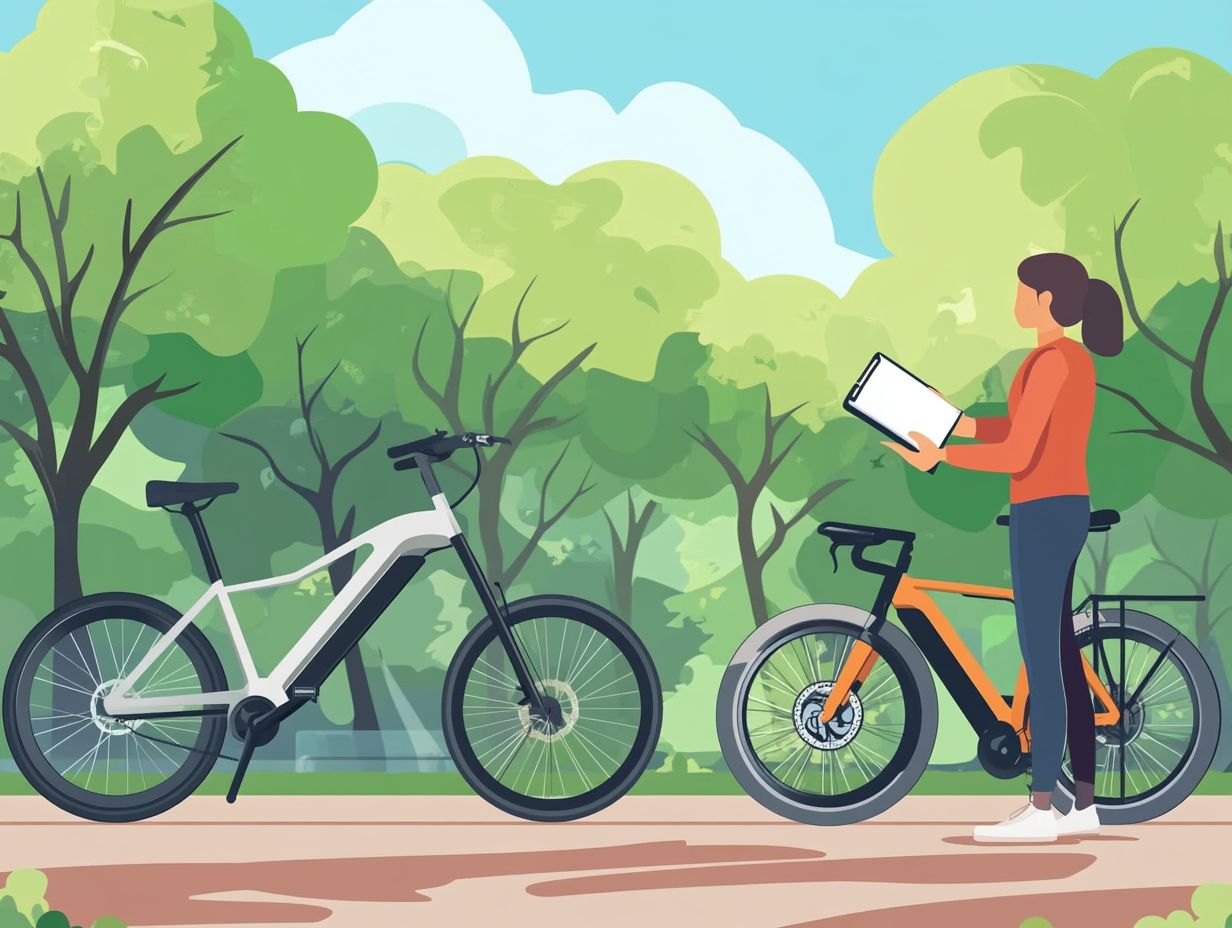
What are the different types of electric bikes?
There are several types of electric bikes, including cruiser, mountain, commuter, folding, and fat tire. Each type has unique features designed for different riding styles and terrains.
What should I think about when choosing an electric bike?
Consider your riding preferences, the terrain you’ll ride on, the distance you plan to travel, and your budget.
What is the difference between a pedal-assist and throttle electric bike?
A pedal-assist electric bike provides assistance to your pedaling, while a throttle electric bike can be operated solely by the throttle without any pedaling. Pedal-assist bikes are more common and offer a more natural riding experience, while throttle bikes are better for riders who may have difficulty pedaling.
Which electric bike type is best for commuting?
A commuter electric bike is ideal because it is designed for urban riding and includes features such as fenders, lights, and racks for carrying items. It also has a comfortable riding position and can handle various road conditions.
Do I need to test ride an electric bike before purchasing?
Yes, testing an electric bike before purchase is important. This allows you to get a feel for the bike’s handling, comfort, and power delivery, ensuring it is the right fit for you.
Are there any legal restrictions for using electric bikes?
The laws regarding electric bikes vary by country and state, so it’s essential to research and understand the regulations in your area. In general, most electric bikes are allowed on bike paths and roads, but there may be restrictions on speed and power.


